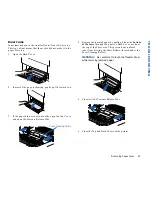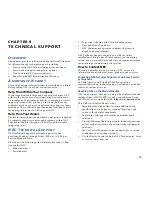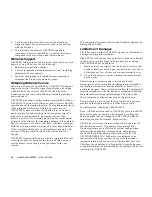
101
APPENDIX C
SAFETY INFORMATION
This chapter provides safety information and product
specifications for the SuperScript 4600N printer. As you
operate your printer, please be aware of the following safety
considerations.
Ozone Emission
The corona assemblies found in laser printers and
photocopiers generate ozone gas (O
3
) as a by-product of the
electrophotographic process. Ozone is only generated while
the printer is printing (while the coronas are energized).
UL Standards for Ozone
The only existing standard for ozone emissions has been
established by Underwriters Laboratory (UL). All
SuperScript family printers meet this standard when shipped
from the factory to our customers.
Employer Responsibilities
Because ozone can be an irritant, various regulatory agencies
have established limits to the amount of ozone to which
employees may be exposed. The employer is responsible for
providing a safe work environment that meets the agencies’
standards.
Recommendations for Minimizing Ozone Exposure
Almost all ozone concerns arise from abnormal site or
operating conditions. The following conditions may generate
an ozone complaint:
•
Installation of multiple laser printers in a confined area
•
Extremely low relative humidity
•
Poor room ventilation
•
The exhaust port of the printer is directed towards the
face of personnel
•
The existing ozone filter is in poor condition
•
Long, continuous printing combined with any of the
above
Inspect your work environment for the operating conditions
listed above if you believe ozone emissions are a problem in
your area. Some people may be ultra-sensitive to ozone odor.
If these situations are encountered, it is advisable to position
the printer away from the sensitive user.
Laser Safety
This printer is certified as a Class 1 laser product under the
U.S. Department of Health and Human Services (DHHS)
Radiation Performance Standard according to the Radiation
Control for Health and Safety Act of 1968. This means that
the printer does not produce hazardous laser radiation.
Since radiation emitted inside the printer is completely
confined within protective housings and external covers, the
laser beam cannot escape from the machine during any phase
of user operation.
CDRH Regulations
The Center of Devices and Radiological Health (CDRH) of
the U.S. Food and Drug Administration implemented
regulations for laser products on August 2, 1976. These
regulations apply to laser products manufactured after
August 1, 1976. Compliance is mandatory for products
marketed in the United States. The printer’s rear panel
indicates compliance with the CDRH regulations and must
be attached to laser products marketed in the United States.
Caution!
Use of controls, adjustments, or
performance of procedures other than those
specified in this user’s guide may result in
hazardous radiation exposure.
Содержание SuperScript 4600N
Страница 1: ...S U P E R S C R I P T 4 6 0 0 N USER S GUIDE October 1999 703 A0364 001 ...
Страница 4: ...iv SuperScript 4600N User s Guide ...
Страница 34: ...26 SuperScript 4600N User s Guide ...
Страница 58: ...50 SuperScript 4600N User s Guide ...
Страница 116: ...108 SuperScript 4600N User s Guide ...



























